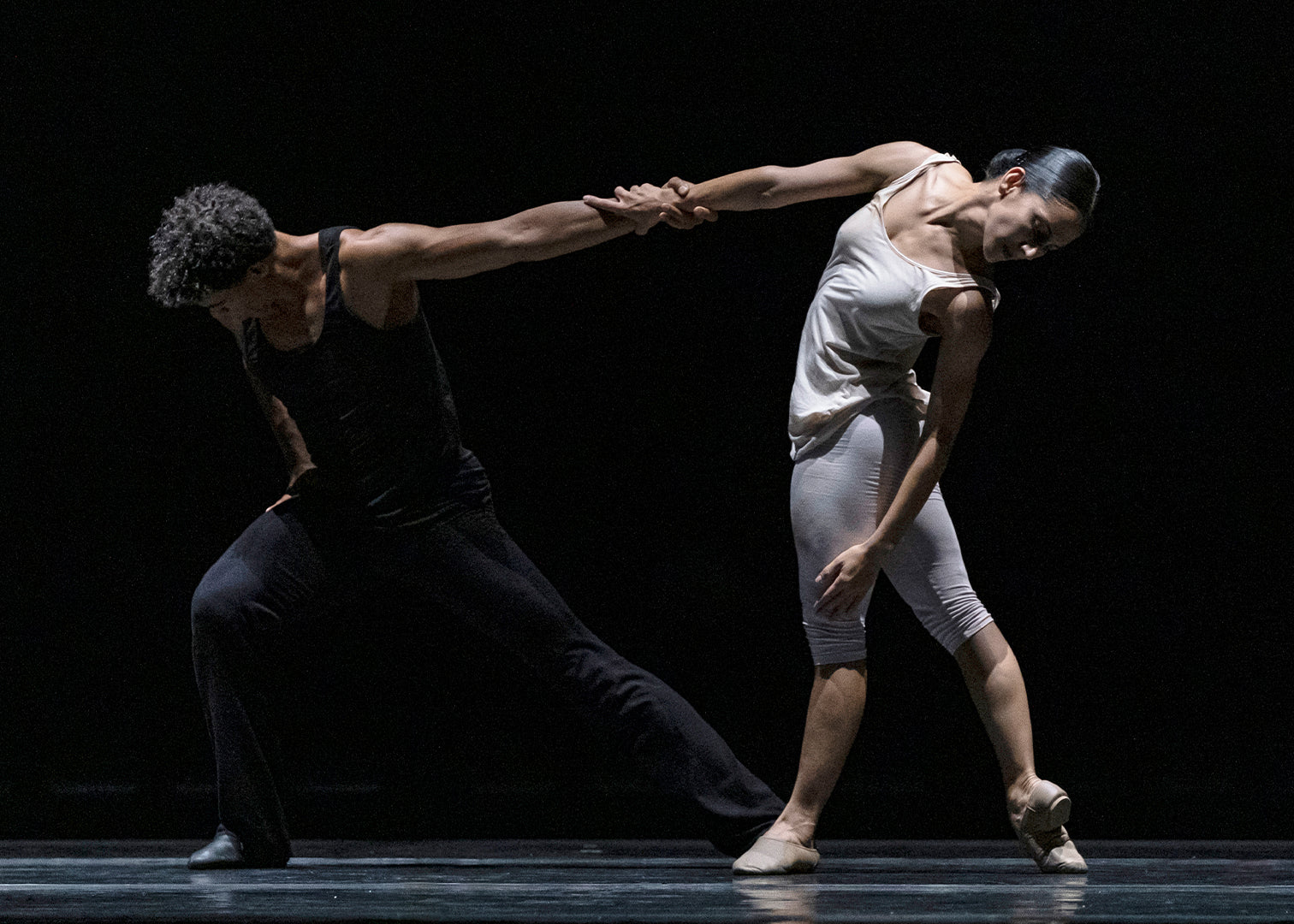Peter Martins’ “Ash” (1991)—a hyperactive athletic romp for a leading pair and four secondary couples—kick started the program with a jolt of energy. The ballet takes its title—and draws much of its unrelenting vigor—from Michael Torke’s propulsive and reiterative score. All sheer power and no emotion, “Ash” faithfully reflects Martins’ trademark style—his fondness for reappearing symmetrical structures, sharp-edge movements and frantic speed.
In the course of the ballet, the five couples crisscrossed the stage in an unstoppable rush of movement, displaying impressive stamina and toughness; it took more than solid technique for the dancers to sustain the grueling tempo of the music and physical hurdles of the choreography. Ashly Isaacs and Taylor Stanley led the excellent cast with remarkable aptitude. Dancing with grace and élan, they made the arduous steps look effortless, even elegant. The entire ensemble was in top form, spicing this vigorous exercise with youthful charm and spirit. As a result, the ballet, which in the beginning seemed like a thoroughly soulless affair, acquired its beating heart.
A sleek and sensual duet, “Sonatas and Interludes,” brought a welcome change of pace to the evening. This evanescent yet deeply evocative piece was created in 1982 by Richard Tanner to a collection of John Cage’s compositions for prepared piano. The music, gorgeously performed by Cameron Grant, was a marvel in its own right, with the warped piano sounding like a hybrid of harp and harpsichord. To accentuate the mystical intricacies of the rasping sound, Tanner, through convoluted yet beautifully-sculpted movements, conjured a wondrous world of ambiguity and suspense and populated it with just two people. Dressed in white, the luminous Sara Mearns and Amar Ramasar immersed themselves into this world, navigating through its haunting secrets with solemn poise and fortitude, their movements perfectly etched, languorous and mesmerizing. The gold lighting by Mark Stanley seductively illuminated the dancers, adding an array of striking details to the overall perception of this highly absorbing piece.
The first part of the program concluded on a gleeful note. A cheerful firecracker, Megan Fairchild, and her playfully exalted partner, Joaquin De Luz, gave it all and then some as they sailed, with wild abandon and a tambourine in hand, through the exuberant steps of George Balanchine’s lighthearted “Tarantella,” set to the music of Louis Moreau Gottschalk. Both dancers have talent, charisma and personality to boot; and they looked so irresistible dancing together that it was impossible not to surrender to sheer joy and exhilaration of their performance.
Justin Peck’s “‘Rōdē,ō: Four Dance Episodes”—an expansive piece for a 16-member cast set to the famous score of Aaron Copland—premiered last season. I was impressed with this ballet then; and I was even more impressed with it this time. Staying true to the essence of the music, in “‘Rōdē,ō,” Peck created visual imagery that is at once sophisticated and unpretentious, lyrical and rambunctious, humorous and utterly humane. His choreography translates in abstract terms a sense of openness and freedom with feelings of camaraderie and closeness. In many ways, this ballet is a poignant rumination on everyday life as told by a young man with wisdom of someone who has lived a hundred lives.
“‘Rōdē,ō” is a stirring showcase of the company’s male power; and the collective energy of the superb cast was the key to the extraordinary success of the performance. Anthony Huxley, Daniel Ulbricht and Andrew Veyette formed a buoyant, high-flying trio in the ballet’s opening and closing sections. Taylor Stanley showed his gentle, lyrical side in the poetic quintet of the second episode, danced to the heart-rending “Corral Nocturne.”
With his inimitable wicked grin, Amar Ramasar, in the ballet’s signature move, pulled the cord from the stage to give the orchestra a visual cue for the jubilant “Hoedown.” Ramasar was the only lucky guy who got to dance with the lone girl during this imaginary rodeo, partnering with Sara Mearns in the ballet’s third section with admirable plasticity and gracefulness.
To cap the evening, the company delivered a rousing rendition of Balanchine’s “Slaughter on Tenth Avenue”—the 1968 remake of the original dance number featured in the 1936 Rodgers and Hart musical “On Your Toes.”
I have a soft spot for “Slaughter.” It’s no masterpiece, but it’s a ballet that unfailingly puts a smile on my face, no matter how many times I’ve seen it. A mélange of humor and horror, it’s a hilarious spoof on gangster movies and backstage jealousy. This comic melodrama takes place in a shabby night club and boasts the most unusual opening act in all ballet: a disgruntled dancer hires an assassin to eliminate his competitor in a love triangle in a cunningly revengeful plot. Yet the main story here revolves around a kindhearted hoofer who falls in love with the club’s sexy stripper who saves his life in the ballet’s surprising finale.
Sporting a shimmering fringed dress, the alluring Teresa Reichlen was a glamorous-looking, high-kicking Striptease Girl; but it was Robert Fairchild as the lovelorn Hoofer who ultimately won the affection of the audience. With loads of charm and a proper Broadway swagger, he tapped his way away from imminent death to happily-ever-after, channeling with wholehearted abandon and uncontainable passion his inner Gene Kelly.









comments